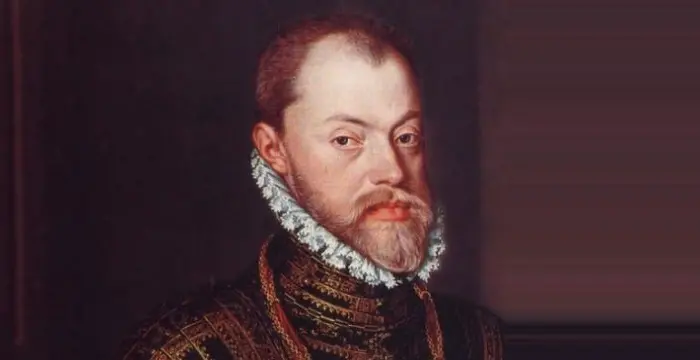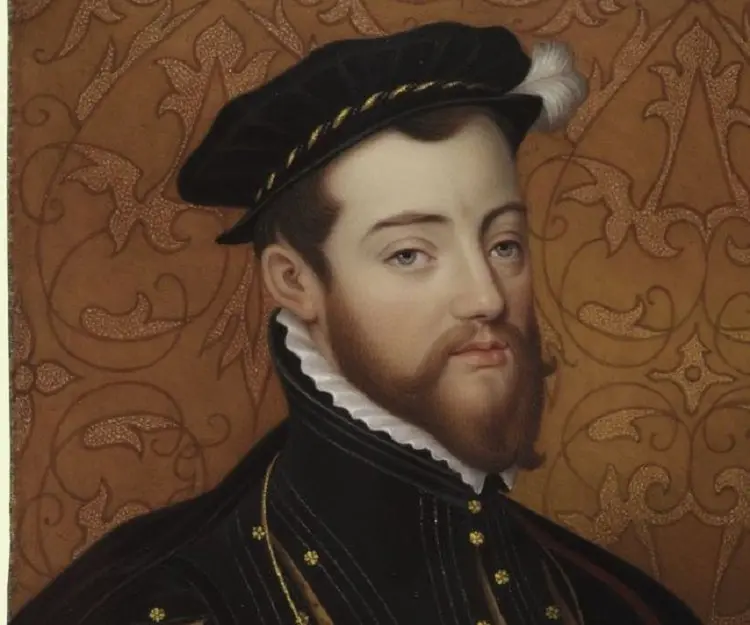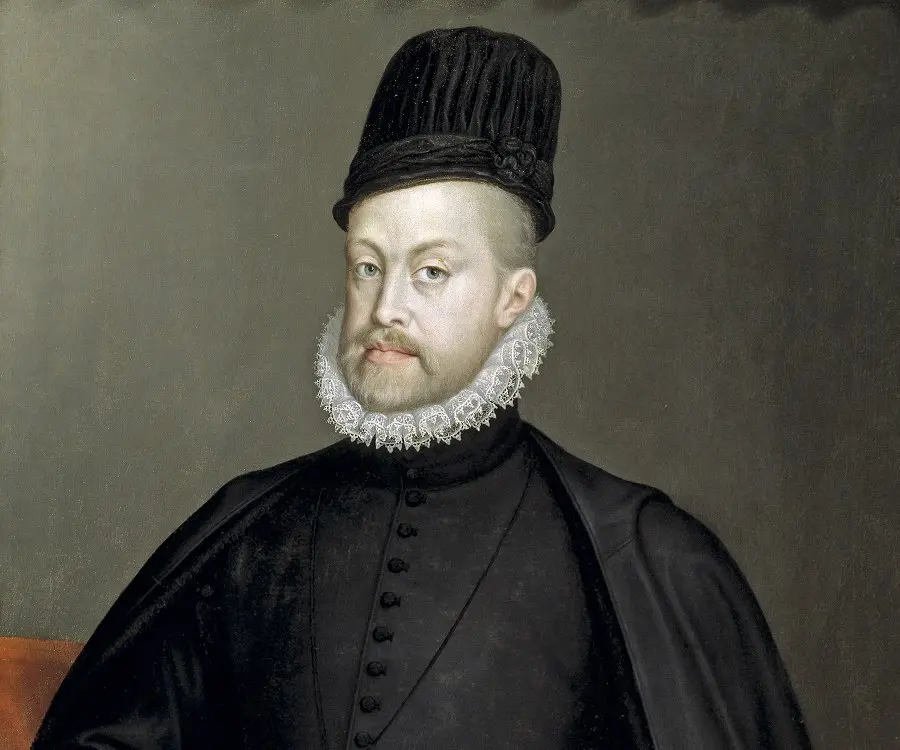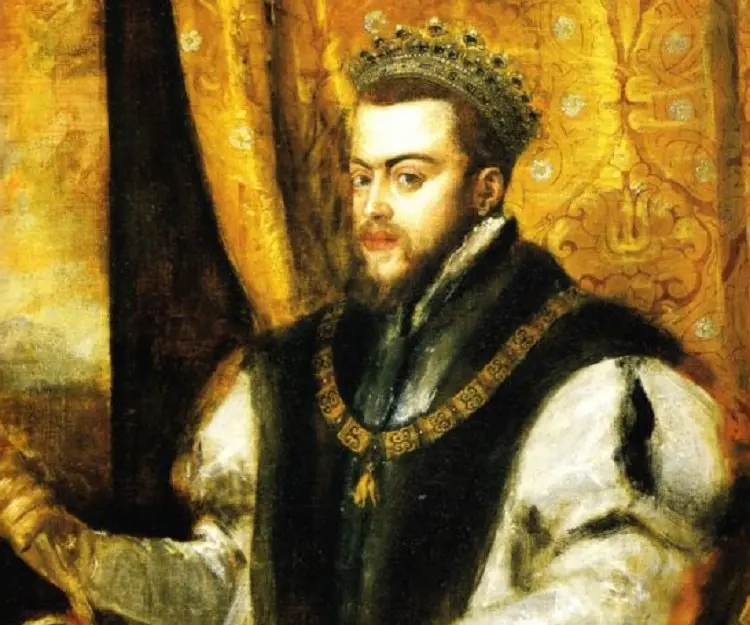
Philip II of Spain - King of Spain, Timeline and Childhood
Philip II of Spain's Personal Details
Philip II was an important Spanish king
| Information | Detail |
|---|---|
| Birthday | May 21, 1527 |
| Died on | September 13, 1598 |
| Nationality | Spanish |
| Famous | Historical Personalities, Emperors & Kings, Emperors, King of Spain, Kings |
| Spouses | Anna of Austria, Elisabeth of Valois, Maria Manuela, Mary Tudor, Princess of Portugal, Queen of Spain |
| Known as | Philip the Prudent, Philip II of the House of Habsburg |
| Childrens | Carlos, Charles Laurence Philip II of Spain, Diego, Ferdinand, Infanta Catherine Michelle of Spain, Isabella Clara Eugenia, Marie of Spain, Philip III of Spain, Prince of Asturias |
| Cause of death |
|
| Birth Place | Pimentel Palace, Valladolid, Spain |
| Gender | Male |
| Father | Charles V, Holy Roman Emperor |
| Mother | Isabella of Portugal |
| Sun Sign | Taurus |
| Born in | Pimentel Palace, Valladolid, Spain |
| Famous as | King of Spain |
| Died at Age | 71 |
// Famous Kings
Sundiata Keita
Sundiata Keita was the founder of the Mali Empire in West Africa. This biography profiles his childhood, early life, struggles, founding of empire, rule, administration, achievements and also gives some fun facts.
Ashoka
Ashoka was the third emperor of the Mauryan Dynasty and ruled almost the entire Indian subcontinent. This biography profiles his childhood, life, reign, achievements and timeline
Murad IV
Murad IV was one of the mighty Sultans in the history of the Ottoman Empire. This biography profiles his childhood, family, accession, rule, administration and timeline.
Philip II of Spain's photo
Who is Philip II of Spain?
King Philip II (Spanish: Felipe II) of Spain, also known as Philip the Prudent or Philip II of the House of Habsburg, was unarguably the most important ruler in Spanish history. It was under his reign that Spain reached the height of its influence and power, and also of its artistic, literary, and musical excellence. As a result, those years are often referred to as the ‘Golden Age’. He was also named the King of Portugal, King of Naples, Duke of Milan, and lord of Seventeen Provinces of Netherlands at various points of his life. For a brief period, he became the jure uxoris King of England and Ireland through his marriage to Queen Mary I. As a young boy, he grew up studious, grave, and mature beyond his years; his formal education and military training receiving equal attention. At the age of 16, his father made him the Regent of Spain, and in the ensuing years he would be the sovereign of a massive empire that would extend to every continent known to contemporary Europeans, leading to the coining of the expression, “the empire on which the sun never sets”. A fervent Roman Catholic, he launched a largely unsuccessful militaristic campaign against the Protestant England in the later years of his reign. In comparison, his endeavours against France and the Ottoman Empire turned out more productive. The islands of Philippines were named so in his honour.
Childhood & Early Life
Born on May 21, 1527, in the Spanish capital Valladolid, Philip was the first child and the only son to reach adulthood of Holy Roman Emperor Charles V and his Portuguese wife, Isabella. He was named after his paternal grandfather, Philip I of Castile. He had two younger sisters, Maria and Joanna, and several paternal half-siblings, including Isabel of Castile, Margaret, Tadea, and John of Austria.
He spent his childhood with his mother at the royal court in Castile. One of her Portuguese ladies, Dona Leonor de Mascarenhas, helped her in rearing him. He forged life-long close relationships with his two pages, Rui Gomes da Silva and Luis de Requesens.
The Spanish culture and court life deeply influenced him. He learned Spanish, Portuguese, and Latin, and demonstrated moderate propensity in arms and letters alike. He enjoyed hunting as a sport and was fond of music. He studied under Juan Martínez Siliceo, the future Archbishop of Toledo and humanist Juan Cristóbal Calvete de Estrella. Classical works were translated into Spanish with his patronage.
After his mother’s death due to a miscarriage, his often-absentee father took an active interest in his upbringing. He received a thorough political education from Charles, who was impressed by his diligence and seriousness. His martial training was overseen by his governor, the commendador mayor of Castile Juan de Zúñiga. He received the practical lessons of warfare from Fernando Álvarez de Toledo, the general Duke of Alba during the Italian Wars (1542-46).
Philip, being the nephew of Christine of Denmark, the widow of the previous Duke Francesco II Sforza, was made the Duke of Milan on October 11, 1540. Three years later, satisfied by his son’s acumen in statesmanship, Charles handed him the regency of Spain. Philip had some of his father’s best advisors to help him govern, such as de Toledo and secretary Francisco de los Cobos. He also had written instructions from his father to rule with "piety, patience, modesty, and distrust."
Accession & Reign
Charles V abdicated in 1554, at the age of 54 after 34 years of active governance that left him physically and mentally exhausted. His brother Ferdinand, who already ruled their ancestral lands in Austria, succeeded him as the Holy Roman Emperor. Philip took over the Spanish empire, and the vast properties in the Netherlands and Italy. The two empires were each other’s greatest of allies till the extinction of the Spanish branch of Habsburg dynasty in the 18th Century.
The most recent addition to the Spanish Empire had been the Kingdom of Navarre. It had been conquered and brought into the empire by Ferdinand II of Aragon in 1512. In his will, Charles expressed his concerns over the kingdom, and proposed that Philip grant Navarre freedom. It did not come to fruition.
They both failed to grasp the elective nature of the crown of the kingdom. After putting down several rebellions, Philip installed Carlos as the King of Navarre and appointed his trusted Castilian officers in the government.
On October 2, 1554, he was crowned the King of Naples by Pope Julius III, and on November 18, ascended to the Sicilian throne. He launched a war on the Papal States in 1556, which is often attributed to Pope Paul IV’s anti-Spanish views. The Pope sued for peace. A treaty was signed between Cardinal Carlo Carafa and the duke of Alba, representing their respective lords, on September 13, 1557.
The final phase of the Italian Wars was a rewarding campaign for Philip and Spain. The Spanish army decisively won against the French at St. Quentin in 1557 and at Gravelines in 1558.
The treaty of Cateau-Cambresis was signed between Philip and Henry II, the King of France, on April 3, 1559. As per the agreement, Piedmont, Savoy, and Corsica were given to allies of the empire. It also ascertained Philip as the sovereign of Milan, Naples, Sicily, Sardinia, and the State of Presidi and ended a war that had lasted for almost 60 years.
He had been financing the Catholic league since the beginning of the ‘French Wars of Religion.’ By the time the Spanish invaded France in 1589, the wars between Catholic and Protestant factions were already 27 years old. Philip sought to unseat Henry IV, who was a Calvinist and put his daughter, Isabel Clara Eugenia, on the French throne.
Henry converted to Catholicism in 1593, declaring an all-out war against Spain in January 1595. The conflict went on until 1598, when the Treaty of Vervins was signed. While Spain did withdraw from the French lands, Philip’s hope to see a Catholic French king had become a reality.
The Seventeen Provinces of the Netherlands were threatened with unrest and chaos during Philip’s reign. War broke out in 1568. The people of the country, who were largely Protestants, were incessantly prosecuted and heavy taxes were levied upon them. In 1566, the Calvinist preachers incited violence against Catholicism. A movement of riots and vandalism, known as the Iconoclast Fury, broke out.
The Dutch independence leader William the Silent was assassinated in 1584, following Philip’s declaration of 25,000 crowns reward for his death. The war continued well after even Philip’s death. In 1648, the independent Dutch Republic came into being.
A succession crisis was set off in Portugal after its young king Sebastian died in 1578 without any heirs. Philip attacked and after a battle at Alcântara, ascended the throne as Philip I of Portugal.
His and his third wife, Mary I of England’s reign as the King and Queen of England and Ireland was catastrophic for the Protestants. So much so, that Mary came to be known as ‘Bloody Mary’.
After the execution of Mary, Queen of Scots, he launched the Spanish Armada to conquer England and put a Catholic on the throne. It was a disaster. Most ships were lost to storms, and the rest were easily defeated by the English forces.
Administrative Policies
Before returning to Spain, Philip spent the early years of his reign in the Netherlands. With the increasing strength of the bureaucracy, Philip’s own authority was confronted by the multiple restrictions implemented by the constitution, despite often being hailed as the absolute monarch. Spain was essentially a federation of separate lands, the local governments of which were known to give priority to self-interest over royal directives.
Philip inherited a debt of about 36 million ducats and an annual deficit of 1 million ducats from his father, which over the course of his reign resulted in five different state bankruptcies in 1557, 1560, 1569, 1575, and 1596. According to some historians, Spain maintaining a huge empire, spending a large amount of the revenues on overseas expeditions, and undertaking multiple expensive domestic projects would end up contributing to its decline within the next hundred years or so.
It was just not his religious fervour that decided his foreign policies; dynastic politics played an equal role too. He made strengthening the Catholic faith his life’s mission and the principal objective of his reign and led a brutal fight against heresy. The Inquisition was a powerful tool in his hand that helped curb religious freedom in the empire.
Major Wars
The Ottoman Empire had grown into the most powerful naval force in the Mediterranean, even more so since their victory over Charles’ Spanish navy in 1541. Philip organized the Holy League with the Republic of Venice, the Republic of Genoa, the Papal States, the Duchy of Savoy and the Knights of Malta in 1560. In 1571, under the leadership of Don John, the Holy League soundly defeated the Turkish forces at the Battle of Lepanto. A peace treaty was signed between the warring parties in 1585.
His greatest military achievement was undoubtedly the decisive victory against Ottoman navy. While the conflict did persist for some years, the Turkish navy was never again a major threat to European powers.
Personal Life & Legacy
Philip II married four times in the course of his life. He married his first wife, who was also his first cousin, Maria Manuela, the princess of Portugal, on November 12, 1543. She died four days after giving birth to their son, Carlos, Prince of Asturias (born 1545), from a haemorrhage suffered during the delivery. She was 17 then.
He was 27 when the marriage between him and Mary I took place. For him, it was strictly a matter of political alliance, while the decade-older Mary was genuinely in love with him. Their union did not produce a child, although there was a case of false pregnancy. After her death on November 17, 1558, Philip unsuccessfully sought to wed her Protestant sister Elizabeth.
Following the signing of Peace of the Cateau-Cambrésis agreement, that marked the end of the 65-year-old conflict between France and Spain, Philip married Princess Elisabeth of Valois, daughter of Henry II of France on June 22, 1559, which was one of the important stipulations of the negotiation.
Elisabeth, who was initially supposed to marry Carlos, conceived five daughters and two sons with Philip, only two of whom survived to adulthood: Isabella Clara Eugenia (1566) and Catherine Michelle (1567). In 1568, Elisabeth died while giving birth to their last child.
His fourth and last marriage was with his niece, Anna of Austria. Married on May 4, 1570, the couple had four sons, Ferdinand, Prince of Asturias (1571), Charles Laurence (1573), Diego, Prince of Asturias (1575), and Philip III, his eventual successor to the Spanish throne (1578), and a daughter, Maria (1580). Eight months after Maria’s birth, Anna suffered heart failure and died.
Philip’s relationship with his eldest son, heir apparent Carlos, was complex. The two barely tolerated each other. After an accident in 1562, in which Carlos fell from a flight of stairs, he suffered severe head injuries and despite a remarkable recovery, became wild and unpredictable. In January 1568, he was put in solitary confinement at the Royal Alcazar of Madrid by his father. He died on July 24 due to malnutrition and eating disorders.
Philip was the ruler of the first major European empire of the modern age, under which arts and sciences progressed by leaps and bounds. However, it was his faith that proved to be an obstacle to his administration. In his effort to suppress Protestantism, he gave the Dutch and the English a powerful rallying point. His treatment of the Moriscos was downright brutal, which led to the Rebellion of the Alpujarras (1568–71).
Aged 71, Philip died of cancer on September 13, 1598, in El Escordial, a palace he himself financed, which is now the historical residence of the King of Spain.
Trivia
He moved his court from Valladolid to Madrid in June 1561, effectively making it the capital of Spanish empire, which it still is today.
// Famous Emperors
Sundiata Keita
Sundiata Keita was the founder of the Mali Empire in West Africa. This biography profiles his childhood, early life, struggles, founding of empire, rule, administration, achievements and also gives some fun facts.
Ashoka
Ashoka was the third emperor of the Mauryan Dynasty and ruled almost the entire Indian subcontinent. This biography profiles his childhood, life, reign, achievements and timeline
Murad IV
Murad IV was one of the mighty Sultans in the history of the Ottoman Empire. This biography profiles his childhood, family, accession, rule, administration and timeline.
Philip II of Spain biography timelines
- // 1512The most recent addition to the Spanish Empire had been the Kingdom of Navarre. It had been conquered and brought into the empire by Ferdinand II of Aragon in 1512. In his will, Charles expressed his concerns over the kingdom, and proposed that Philip grant Navarre freedom. It did not come to fruition.
- // 21st May 1527Born on May 21, 1527, in the Spanish capital Valladolid, Philip was the first child and the only son to reach adulthood of Holy Roman Emperor Charles V and his Portuguese wife, Isabella. He was named after his paternal grandfather, Philip I of Castile. He had two younger sisters, Maria and Joanna, and several paternal half-siblings, including Isabel of Castile, Margaret, Tadea, and John of Austria.
- // 11th Oct 1540Philip, being the nephew of Christine of Denmark, the widow of the previous Duke Francesco II Sforza, was made the Duke of Milan on October 11, 1540. Three years later, satisfied by his son’s acumen in statesmanship, Charles handed him the regency of Spain. Philip had some of his father’s best advisors to help him govern, such as de Toledo and secretary Francisco de los Cobos. He also had written instructions from his father to rule with "piety, patience, modesty, and distrust."
- // 1541The Ottoman Empire had grown into the most powerful naval force in the Mediterranean, even more so since their victory over Charles’ Spanish navy in 1541. Philip organized the Holy League with the Republic of Venice, the Republic of Genoa, the Papal States, the Duchy of Savoy and the Knights of Malta in 1560. In 1571, under the leadership of Don John, the Holy League soundly defeated the Turkish forces at the Battle of Lepanto. A peace treaty was signed between the warring parties in 1585.
- // 1542 To 1546After his mother’s death due to a miscarriage, his often-absentee father took an active interest in his upbringing. He received a thorough political education from Charles, who was impressed by his diligence and seriousness. His martial training was overseen by his governor, the commendador mayor of Castile Juan de Zúñiga. He received the practical lessons of warfare from Fernando Álvarez de Toledo, the general Duke of Alba during the Italian Wars (1542-46).
- // 12th Nov 1543 To 1545Philip II married four times in the course of his life. He married his first wife, who was also his first cousin, Maria Manuela, the princess of Portugal, on November 12, 1543. She died four days after giving birth to their son, Carlos, Prince of Asturias (born 1545), from a haemorrhage suffered during the delivery. She was 17 then.
- // 1554Charles V abdicated in 1554, at the age of 54 after 34 years of active governance that left him physically and mentally exhausted. His brother Ferdinand, who already ruled their ancestral lands in Austria, succeeded him as the Holy Roman Emperor. Philip took over the Spanish empire, and the vast properties in the Netherlands and Italy. The two empires were each other’s greatest of allies till the extinction of the Spanish branch of Habsburg dynasty in the 18th Century.
- // 1554On October 2, 1554, he was crowned the King of Naples by Pope Julius III, and on November 18, ascended to the Sicilian throne. He launched a war on the Papal States in 1556, which is often attributed to Pope Paul IV’s anti-Spanish views. The Pope sued for peace. A treaty was signed between Cardinal Carlo Carafa and the duke of Alba, representing their respective lords, on September 13, 1557.
- // 1557 To 1558The final phase of the Italian Wars was a rewarding campaign for Philip and Spain. The Spanish army decisively won against the French at St. Quentin in 1557 and at Gravelines in 1558.
- // 17th Nov 1558He was 27 when the marriage between him and Mary I took place. For him, it was strictly a matter of political alliance, while the decade-older Mary was genuinely in love with him. Their union did not produce a child, although there was a case of false pregnancy. After her death on November 17, 1558, Philip unsuccessfully sought to wed her Protestant sister Elizabeth.
- // 3rd Apr 1559The treaty of Cateau-Cambresis was signed between Philip and Henry II, the King of France, on April 3, 1559. As per the agreement, Piedmont, Savoy, and Corsica were given to allies of the empire. It also ascertained Philip as the sovereign of Milan, Naples, Sicily, Sardinia, and the State of Presidi and ended a war that had lasted for almost 60 years.
- // 22nd Jun 1559Following the signing of Peace of the Cateau-Cambrésis agreement, that marked the end of the 65-year-old conflict between France and Spain, Philip married Princess Elisabeth of Valois, daughter of Henry II of France on June 22, 1559, which was one of the important stipulations of the negotiation.
- // Jun 1561He moved his court from Valladolid to Madrid in June 1561, effectively making it the capital of Spanish empire, which it still is today.
- // 1562 To Jan 1568Philip’s relationship with his eldest son, heir apparent Carlos, was complex. The two barely tolerated each other. After an accident in 1562, in which Carlos fell from a flight of stairs, he suffered severe head injuries and despite a remarkable recovery, became wild and unpredictable. In January 1568, he was put in solitary confinement at the Royal Alcazar of Madrid by his father. He died on July 24 due to malnutrition and eating disorders.
- // 1566 To 1568The Seventeen Provinces of the Netherlands were threatened with unrest and chaos during Philip’s reign. War broke out in 1568. The people of the country, who were largely Protestants, were incessantly prosecuted and heavy taxes were levied upon them. In 1566, the Calvinist preachers incited violence against Catholicism. A movement of riots and vandalism, known as the Iconoclast Fury, broke out.
- // 1567Elisabeth, who was initially supposed to marry Carlos, conceived five daughters and two sons with Philip, only two of whom survived to adulthood: Isabella Clara Eugenia (1566) and Catherine Michelle (1567). In 1568, Elisabeth died while giving birth to their last child.
- // 1568Philip was the ruler of the first major European empire of the modern age, under which arts and sciences progressed by leaps and bounds. However, it was his faith that proved to be an obstacle to his administration. In his effort to suppress Protestantism, he gave the Dutch and the English a powerful rallying point. His treatment of the Moriscos was downright brutal, which led to the Rebellion of the Alpujarras (1568–71).
- // 1570His fourth and last marriage was with his niece, Anna of Austria. Married on May 4, 1570, the couple had four sons, Ferdinand, Prince of Asturias (1571), Charles Laurence (1573), Diego, Prince of Asturias (1575), and Philip III, his eventual successor to the Spanish throne (1578), and a daughter, Maria (1580). Eight months after Maria’s birth, Anna suffered heart failure and died.
- // 1578A succession crisis was set off in Portugal after its young king Sebastian died in 1578 without any heirs. Philip attacked and after a battle at Alcântara, ascended the throne as Philip I of Portugal.
- // 1584 To 1648The Dutch independence leader William the Silent was assassinated in 1584, following Philip’s declaration of 25,000 crowns reward for his death. The war continued well after even Philip’s death. In 1648, the independent Dutch Republic came into being.
- // 1589He had been financing the Catholic league since the beginning of the ‘French Wars of Religion.’ By the time the Spanish invaded France in 1589, the wars between Catholic and Protestant factions were already 27 years old. Philip sought to unseat Henry IV, who was a Calvinist and put his daughter, Isabel Clara Eugenia, on the French throne.
- // 1593Henry converted to Catholicism in 1593, declaring an all-out war against Spain in January 1595. The conflict went on until 1598, when the Treaty of Vervins was signed. While Spain did withdraw from the French lands, Philip’s hope to see a Catholic French king had become a reality.
- // 13th Sep 1598Aged 71, Philip died of cancer on September 13, 1598, in El Escordial, a palace he himself financed, which is now the historical residence of the King of Spain.
// Famous Historical Personalities
Sundiata Keita
Sundiata Keita was the founder of the Mali Empire in West Africa. This biography profiles his childhood, early life, struggles, founding of empire, rule, administration, achievements and also gives some fun facts.
Ashoka
Ashoka was the third emperor of the Mauryan Dynasty and ruled almost the entire Indian subcontinent. This biography profiles his childhood, life, reign, achievements and timeline
Jetsun Pema
Jetsun Pema is the Queen consort of Bhutan. Check out this biography to know about her childhood, family life, achievements and fun facts about her life.
Murad IV
Murad IV was one of the mighty Sultans in the history of the Ottoman Empire. This biography profiles his childhood, family, accession, rule, administration and timeline.
Xerxes I
Xerxes I (Xerxes the Great) was the fourth and the most famous king of the Archaemenid dynasty of Persia. This biography profiles his childhood, family, personal life, life history, achievements, campaigns, administration, death and other facts.
Sargon of Akkad
Sargon of Akkad, also called ‘Sargon the Great’, ‘Sarru-Kan’ and ‘Shar-Gani-Sharri’, was the founder and first king of the Akkadian Empire. This biography profiles his childhood, life, rule, administration, timeline, and gives some fun facts.
Philip II of Spain's FAQ
What is Philip II of Spain birthday?
Philip II of Spain was born at 1527-05-21
When was Philip II of Spain died?
Philip II of Spain was died at 1598-09-13
Which age was Philip II of Spain died?
Philip II of Spain was died at age 71
Where is Philip II of Spain's birth place?
Philip II of Spain was born in Pimentel Palace, Valladolid, Spain
What is Philip II of Spain nationalities?
Philip II of Spain's nationalities is Spanish
Who is Philip II of Spain spouses?
Philip II of Spain's spouses is Anna of Austria, Elisabeth of Valois, Maria Manuela, Mary Tudor, Princess of Portugal, Queen of Spain
Who is Philip II of Spain childrens?
Philip II of Spain's childrens is Carlos, Charles Laurence Philip II of Spain, Diego, Ferdinand, Infanta Catherine Michelle of Spain, Isabella Clara Eugenia, Marie of Spain, Philip III of Spain, Prince of Asturias
What is Philip II of Spain's cause of dead?
Philip II of Spain dead because of Cancer
Who is Philip II of Spain's father?
Philip II of Spain's father is Charles V, Holy Roman Emperor
Who is Philip II of Spain's mother?
Philip II of Spain's mother is Isabella of Portugal
What is Philip II of Spain's sun sign?
Philip II of Spain is Taurus
How famous is Philip II of Spain?
Philip II of Spain is famouse as King of Spain








